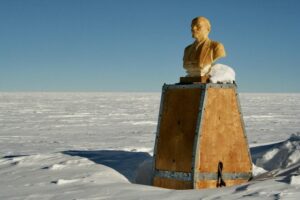Kaliningrad, Kaliningrad, Kaliningrad.
Mr Putin, we shall tear up Kaliningrad.
Maybe, we can teach you the lines,
Mr President.
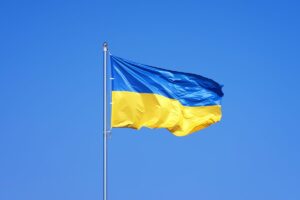
When Hitler swept across Poland, a similar terrain to Ukraine in the autumn of 1939, it took 38 days for Poland to be subdued. Hitler had help from whom else? Of course, the Soviet Union, which joined in the feeding dismemberment on 17 September; while the hyaenas were members of the Slovak Nazi militia, a by-product of the same process the year before when Czechoslovakia was occupied by Hitler.
Now Putin is out to emulate Hitler by invading the Ukraine to satisfy his imperial megalomania. Thirty-eight days is the target, Vladimir.
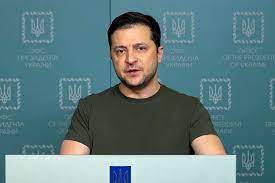
Putin calculated that if America did not intervene, then he knows Europe won’t because which of the NATO states will deliver the first blow. When Putin’s forces occupied Crimea, the Ukrainian reaction was to remove his ally as President, Viktor Yanukovych, who not unsurprisingly came from Donesk. Ukrainians elected a TV comedian, Volodymyr Zelensky, who seems to have more intestinal fortitude than many of his ilk. The caption on a recent photograph – “Leader of the Free World” – might have been intended irony, but much of irony can be ascribed as truth.
Nevertheless, the circumstances which enabled Putin to develop his strategy, whether complicitous or not, were due to Trump. Without the chaos Trump caused, coupled with his hatred of his own country, it is doubtful where Putin would have accumulated the resources to enable the invasion. In addition, he fed the foetal Trump ego.
Already in the “Free World” there was too much of the appeasement mentality throughout the past two decades. Both the Bush and Obama Presidencies passed by, where the underlying determination and hatred for America by Putin lay undetected. Even in this past week, the spokespeople from the State Department were still whimpering about diplomacy.
Before the rise of Putin, the Balkan war in the 1990s was a nasty European prelude, but it happened when Russia was a weakened remnant of the Soviet Union. However, the thugs then in the ascendency in Serbia were intent on genocide of their Muslim brothers and sisters – not to mention the Croats. All separated by religion, but basically the same Slavs with a common spoken language. Nevertheless, the Greater Serbia looms large in the mythology of Slavic dominance, allied as it is to the Orthodox Church mysticism – and another front for Putin mischief.
The spring thaw is coming in Ukraine and then the ground will turn to mud. It is black soil – lovely to drive on when dry, but when wet, it turns to mud, and then it is a nightmare to navigate, as I found out on the black soil plains of Northern New South Wales.
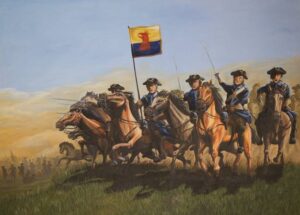
Despite the black soil, expansion of Russian power has been helped over the centuries by the various despot rulers having exceptional generals going as far back to Peter the Great. It was here that Prince Menshikov’s cavalry, and in particular Count Boris Sheremetev’s infantry and artillery, was crucial in the destruction of Swedish influence at the Battle of Poltrava in 1709, thus changing the whole power relationship of northern Europe.
The obvious Soviet playbook end point for the Ukraine is a puppet state with a secret police full of sociopathic killers – but there is a cost which Russia’s economy may not, in the long term, be able to sustain. Areas where Russia derives its income will be sanctioned by the EU, Great Britain, USA and others. Unless Putin has the capacity to further loot, where will the funding come from now? In Europe he has only Moldova, Finland, Sweden and some of the Balkan countries that are not members of NATO. Looting Belarus would be like robbing your cousin’s two-dollar store.
However, this heir to Poltrava needs many more resources to continually expand his imperial obsession – but wait, there is Serbia, a natural ally. The Serbs in Bosnia Herzegovina are restless – talks of secession in the air. More destabilisation – more misinformation.
I do not believe that NATO is sitting on its hands. It is hesitant, because even if Russia has a comparatively small GDP (look around and see what you have that is Russian), Russia does have a considerable nuclear arsenal.
You see, The Economist put forward a perfectly logical outcome to this adventurism. It was written prior to the invasion; but do we have a new logic?
Mr Putin cannot revive growth, for that would require structural reforms that would destabilise politics. He cannot reverse the brain drain, because that would require taming his security services. He cannot deal with the demands of the young or the regions, because that would require him to quit. An isolated, bored and ageing leader, increasingly reliant on a small coterie of similar age and KGB background, he prefers geopolitical posturing and war games, where results are visible and instantly gratifying. He is reconciled to ruling by fear, not guile and the cultivation of common interests; if he understands Mr Greene’s 17th Law of Power, he has failed to master the 18th: “Do not build fortresses to protect yourself—isolation is dangerous”.
Yes, but so is Putin a dangerous brooding person, who seems not to conform to any reasonable expectations. Eventually, if he survives, the Chinese will find out in Central Asia – but first “I have to destroy Western Europe”.
Good one Murdoch
The Lincoln Project has released an indictment. What it is stating, without committing to print. “Go, verify yourself, Murdoch?”
Personally given the influence of Murdoch over our government, I am affronted. Do we Australians still want to associate ourselves with this Organisation which employs such a person as Tucker Carlson?
You know what England did with the Hitler’s propagandist, the New York-born Lord Haw Haw, in 1946.
I don’t know whether being born in San Francisco would grant you an exemption, Carlson, when ultimately retribution will be handed out.
And on record, I abhor capital punishment, but at times… but let’s read what the Lincoln Project has to say.
American soldiers, sailors, airmen, and Marines here at home and deployed around the world are being bombarded by enemy propaganda.
That’s because Fox News is the official channel airing on U.S. bases around the world.
Recently, Fox News and Russian propaganda media have been working from the same exact playbook, pushing the same anti-American and anti-democratic propaganda.
Don’t take our word for it; the Kremlin is using footage from Tucker Carlson and the Fox crew right now to justify their invasion of Ukraine:
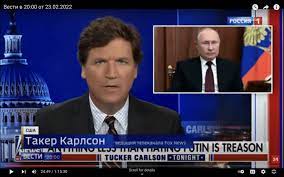
It would be one thing if this was the mandatory viewing at Mar-A-Lago or the halls of CPAC. Fox is the default news network at U.S. military bases across the world…and our troops deserve better.
Kremlin propaganda is being piped into the minds of our very own U.S. soldiers while they stand ready to defend our country. It’s time for the Biden Administration to take action.
We can’t let our soldiers be victimized by pro-russia, pro-Putin Fox propaganda. Add your name so we can give the White House the support it needs to help us to #BanFoxFromBases now.
While this was alluded to on Media Watch this week, let’s delve deeper. The magazine Vanity Fair has revealed that this Carlson, this Fox opinionate, now is trying to break the land speed back-pedalling record
Prior to Thursday, Carlson was this-close to inviting Putin on his show and asking him, “Any chance we can get you to run in 2024? I know it’s a long shot but…I’d love to see it.”
Yes, if you missed Carlson‘s most recent shows, a quick recap of commentary he’s offered on the situation:
- It’s “not un-American” to support Putin;
- Democrats will find you guilty of treason if you don’t hate Putin;
- The whole thing is simply a “border dispute” ;
- “Ukraine is not a democracy”;
- Ukraine is a “puppet of the West”; and
- Our personal favourite, “that unless Vladimir Putin has personally had you or one of your family members murdered, you really don’t have any right to criticize the guy.”
I hate to say it, but what is the brown stuff on each of the Sky News commentator’s shirtfronts. I guarantee it is not Vegemite.
John Landy
Central Park is one of those leafy multipurpose places which are the touchstones for a garden city like Melbourne. It was very much a part of my childhood where we used to have a Sunday picnic and where, if you lived in Darling, as my family did up to when I was twelve, one walked through Hedgeley Dene to get to the Park. Later I played cricket on one of the Park’s ovals.
John Landy, the great Australian athlete, used to train there in the days when running was just a pure expression of maximising your ability.
As a boy, Landy would have been a contemporary of Rupert Murdoch at Geelong Grammar school, both of whom turned out to be men of strong will – one of whose major goals was accomplished before the other had begun.
I met John Landy several times socially. He was not a person in such an environment to make you look twice. He was quiet and unassuming, with a curious habit of bending forward and clasping his hands before his chest when making a conversational point, as one writer observed.
It was another matter when that lithe athlete strode onto the running track. His rivalry with Roger Bannister to be the first sub-minute miler was one of those challenges that concentrated the collective mind in the early 1950s.
When Landy ran onto the track, he became a different person. He tended to run from the front and in doing so demonstrated his mastery in middle distance running. Yes, Bannister beat him in bettering the four minute mile and then because Landy looked over his left shoulder at the Vancouver Empire Games mile in 1954, lost momentum and was beaten in the last hundred metres by Roger Bannister.
I saw Landy in one of the greatest runs of his life and that was in the 1500 metres final at the 1956 Olympic games. Landy was not a tactical runner in that he liked to be in front and the others had to catch him.
In the 1500 metres final he was shuffled back and was forced to make his run on the outside of the field. I never forget this lean figure sprinting on the outside just before the turn into the final straight. The commitment was absolute; the style was flawless; he was trying to stay away from a bumping duel. Then he had gone past, and all I saw was a pack of runners at the winning post. For an instant I hoped Landy had got up to win – but it was not to be. His was a bronze medal. The gold medallist was an Irishman named Ron Delaney, then a student at Villanova University in America. Second was an East German and then Landy. It was a magnificent run by a magnanimous man.
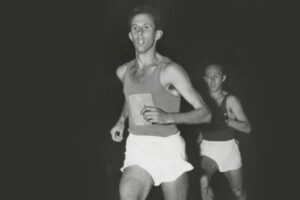
A few years ago, I had a spare day in Finland and we were staying near the Helsinki railway station. I said to my companion, “Let’s go to Turkü.” It was quite effort – having to change platforms and Finnish train doors are uncompromisingly automatic. For disabled people this is a challenge and to avoid being wedged, you have to throw yourself on at just the right moment, crutches and all. Then when we got to Turkü, we alighted at the far end of a long windswept platform; fortunately, there was one taxi on the rank that had not been taken.
Turkü is a very pleasant place, particularly famous for its mediaeval castle. My only souvenir was a felt trivet in the shape of Finnish traditional rye bread with a hole in the centre. (ruisreikäleipä).
What had this trip to do with Landy? Well, it was a sort of pilgrimage. I had always wanted to go to the place where Landy broke the world mile record in 1954 registering 3.57.9 on a cinder track, a record which stood for three years.
At the time of his death recently, the world mile record had been progressively reduced to 3.43.13, which has stood since 1999, run by a Moroccan, Hicham el Guerrouj.
But nobody can remove from my memory that grainy photograph of Landy breasting the tape in Turkü, some 58 years ago. Just going to Turkü fulfilled a promise I made years ago that I would one day go there. Landy was just that important to a once teenage Australian.
The Oklahoma Panhandle
If you had the urge to travel around five States in America you could start on the Oklahoma panhandle – a tongue-like intrusion between Texas on the south side, Kansas and Colorado to the North and (as we have done, entered Oklahoma) on the western edge from New Mexico. Here there is very impressive sign telling you that you have entered Oklahoma.
The Panhandle is a very dry area, which in the thirties became the dustbowl from where the farmers, termed Okies left. It was a classic result of not looking after the environment. Even today, it is flat bleak landscape and as we were driving towards the main township of Guymon, a tornado warning came over the car radio. This strip of land is part of tornado alley, which stretches north from the Gulf of Mexico until the warm and cold air stream collide to form tornadoes, mostly in late spring and early summer.
On this day, the tornado warning mentioned Guymon, towards which we were driving; but after some consternation, there was relief when the tornado was moving away from ourselves on the other side of Guymon.
I had never heard of Sanora Babb until my attention was drawn to a newly published collection of essays about her: “Unknown No More” subtitled “Recovering Sanora Babb”.
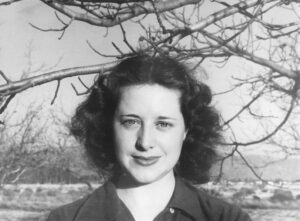
Sanora Babb herself was born in 1907 in Oklahoma and died on the last day of 2005.
Then I read Sanora Babb’s autobiographical novel – An Owl on Every Post. It is a beautifully written tracery of Sanora Babb growing up with her sister, father and mother in her grandfather’s dugout. Alonso, her grandfather, is sharply drawn.
The description of childhood poverty is matched by her optimism, her sharp eye for detail and her eventual emergence being able to attend school. This emergence and her adolescence and awakening in terms of realising the importance of gender is crammed into the final chapters of the book.
Her family was forced, because of the penury caused by her father’s gambling, to move from Oklahoma to the altiplano of Eastern Colorado, where her grandfather scrabbled an existence out of growing broom millet.
If the crop failed, then they had no money and little to eat. Yet this is not a self-pitying book; one feels the impression of a life lived in an unforgiving environment where the winter was savage and the cry of coyotes a reminder of the wilderness in which they subsisted.
The family lived through the death of a brother in childbirth and their mother’s slow recovery. It was part of the self-contained existence. You survived; there were no nuances, learning to read from a Kit Carson book and Denver Post newspaper cuttings pasted on the dugout walls. There was Bounce the dog and Daft the horse, in its free-range gallop, which ended tragically in him falling into a ravine.
Then they are given a lifeline to move from the dugout to Kansas, to the township of Elkhart, which my wife and I remember passing through 70 years later. It is difficult to forget, because along the southern border where the railway line runs, so runs the Oklahoma border. That evening we stayed close by at Liberal, Kansas, but that’s another story.
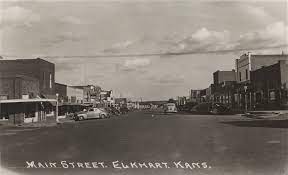
There is no memorial to Sanora there, but then she had largely been forgotten. The fact that she was a Communist may have had something to do with it; others said her literary achievements were overshadowed by those of John Steinbeck. But who knows? Taste in literature is a very ephemeral matter.
As Alan Wald wrote in an essay entitled: Sanora Babb in Her Time and Ours, “In my view, however, the reconstruction of Babb’s entire career is still very much in progress … Babb may have commenced as our plebian Jane Austen of the plains with a motive of committing acts of earnest witnessing. Over time, though her art increasingly suggests a socialist Vermeer, patiently observing and chronicling daily life from angles, odd and slanted …
Craft conscious as well as class conscious, Babb’s writing can be bittersweet, elegant, and faintly wistful, sometimes with a grim documentary frisson. She can pour herself into nooks and crannies of her characters’ contradictions, even as her vision is undergirded by a Marxian awareness of the structure of oppression. The result is that she pushes the boundaries of empathy to value humanity as undivided and seemingly the zeitgeist of at least two ages – the Great Depression and the New Millennium. No wonder the faces staring out from much of her fiction at times have a startling immediacy.”
I wonder why I found Sanora Babb so entrancing, even though I have only read one of her books – I never thought of her providing me with a link between Jane Austen and Johannes Vermeer, both of whose works I greatly admire. Learn something every day.
Helô – It’s St David’s Day
In March, Paddy’s Day gets all the attention, with creatures in tall green hats and foaming glasses of Guinness searching for their Irish heritage throats. Last Tuesday, it was St David’s Day, the national day for the Welsh. Yet it is a day that goes unnoticed by most of us.

St David is the patron saint of Wales and St David’s Day falls on 1 March, the date of his death in 589. It is not a national holiday in the UK or even a bank holiday in Wales, despite numerous campaigns. After all, the English first tried to suppress Wales and its language in the Act of Union in 1536.
The feast has been regularly celebrated since the canonisation of David in the 12th century by Pope Callixtus II. Callixtus was a Burgundian of noble birth. An enlightened pope, he initiated canon law decrying anti- Semitism (as well as laws forbidding simony and concubinage by the clergy).
St David for his part set up monastic communities in what is now Devon and Cornwall as well as Brittany; and his ascetic existence would have not been the most attractive as he harnessed literally his monks to plough the fields.
St David’s Day has been celebrated in Australia since at least the 1840s, as has been reported. In Melbourne, for instance, the 1865 festivities had the then Cambrian Society President B. G. Davies, MLA fulminating: “I am aware that many taunts and jeers are directed at Welshmen for so warmly adhering to the customs and traditions of their motherland… The English have their Shakespearian festivals, the Scotch their meetings in memory of Burns, and the Irish delight in commemorating their St Patrick… so why should not the sons of dear old Cambria meet in honour of their patron saint, and hold converse in the immortal language he so nobly uttered.”
So why not?
Well, it could be said the Welsh do have their Eisteddfod, and we could have Welsh choirs singing ‘Land of my Fathers” and have people dolled up in traditional Welsh dress cavorting the landscape and watching re-runs of “How Green was my Valley” or readings from Dylan Thomas.
To celebrate St David’s Day I wanted to have cawl – the Welsh national dish, but she who is the cook said she was not going to stand over a cauldron of lamb stew, replete with swedes, rutabaga, mangelwurzels, potatoes and carrots for a day and a half. Anyway we did not have access to Caerphilly cheese, an essential ingredient.
In the end we settled for Welsh rarebit and bara brith (speckled bread), leaving laverbread, and Welsh cakes for another day. Then there is always the vegetarian Glamorgan sausage where leeks are an essential ingredient. (We did have leeks cooked with Welsh balsamic vinegar and olive oil for dinner).
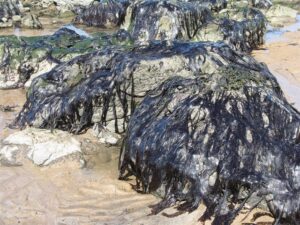
Laverbread makes the difference if you want a Welsh breakfast rather than that of a full on English breakfast. Laverbread is seaweed, dried, peppered and salted combined with oatmeal, and the best apparently comes from the Pembrokeshire coast.
So next year we shall be better prepared and we may even invite people who do actually have Welsh genes.
And talking of drops – beer seems to be the Welsh drink of choice but there is cider, perry and a form of mead named metheglin, this last predominantly a Yuletide intoxicant. But then given that the Welsh are “chapel”, we tend not to raise our voices too much when mentioning alcohol, melodious though these voices may be.
A proud brave young Australian
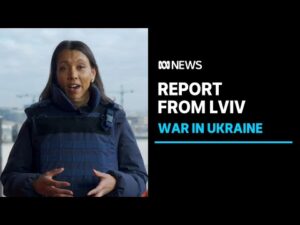 Below Isabella Higgins was reflecting on where she came from in a piece written three years ago. Now she is the ABC face in the Western Ukraine.
Below Isabella Higgins was reflecting on where she came from in a piece written three years ago. Now she is the ABC face in the Western Ukraine.
Many of us know that acceptance, inclusion and respect between black and white Australia is possible, because we’re the walking, breathing proof. Take my family for example. We’re proud Torres Strait Islanders, but we also have German and British ancestry. We are an embodiment of multicultural Australia. My great-grandmother came to this country as a WWII refugee, raised in Nazi Germany.
Mouse Whisper
Australia wants to assist the Ukraine, because the rhetoric from our political leaders is full of it. The problem we have is the technology to keep the lettuce leaves warm enough for them to reach President Zelensky is proving troublesome.
How about doing something which will hurt, and blockade the Russian bases in Antarctica, for contravention of the Antarctic Treaty of which both Australian and Russia were original signatories in 1961. There is prohibition on a number of matters, mostly related to militarisation (except for research) and disposal of nuclear waste – a case for preventing “putridisation”
Seriously, here is an area where Australia could pressure Russia, especially as Ukraine is also one of the signatories. After 61 years, it would appear to be a time for a review on the legitimacy of those countries which have established bases in Antarctica. Russia is showing that it has no legitimacy wherever it has plonked down its flag.
If Australia wishes to really cause Russia pain, the Antarctic is just the place.
But then again, I am just a humble mouse who occasionally dines on warm lettuce leaves, but I have stopped drinking Russian vodka. Putin must tremble when he hears that.
